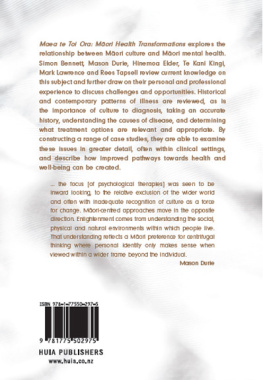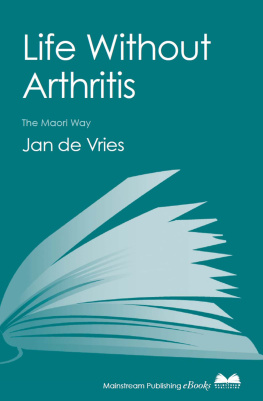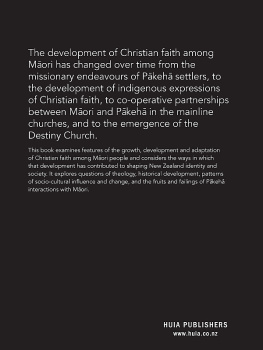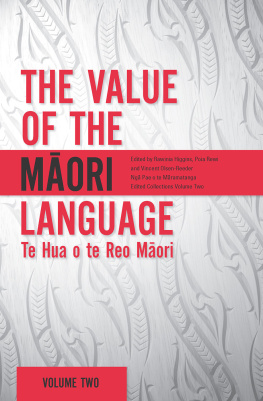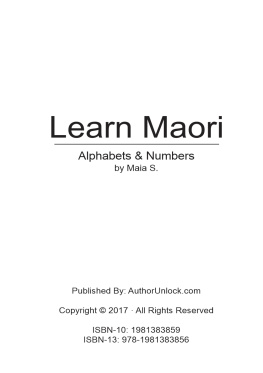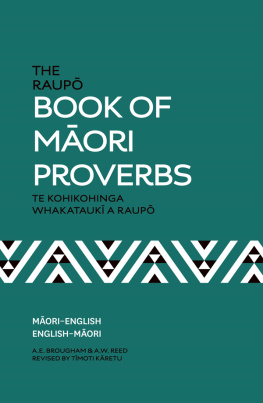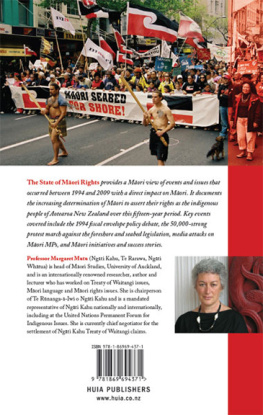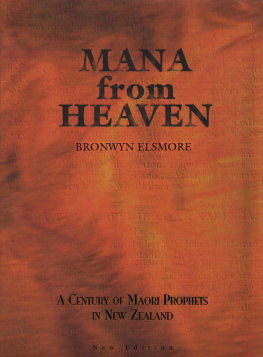Rees Tapsell - Maea te Toi Ora: Maori Health Transformations
Here you can read online Rees Tapsell - Maea te Toi Ora: Maori Health Transformations full text of the book (entire story) in english for free. Download pdf and epub, get meaning, cover and reviews about this ebook. year: 2018, publisher: Huia (NZ) Ltd, genre: Politics. Description of the work, (preface) as well as reviews are available. Best literature library LitArk.com created for fans of good reading and offers a wide selection of genres:
Romance novel
Science fiction
Adventure
Detective
Science
History
Home and family
Prose
Art
Politics
Computer
Non-fiction
Religion
Business
Children
Humor
Choose a favorite category and find really read worthwhile books. Enjoy immersion in the world of imagination, feel the emotions of the characters or learn something new for yourself, make an fascinating discovery.
- Book:Maea te Toi Ora: Maori Health Transformations
- Author:
- Publisher:Huia (NZ) Ltd
- Genre:
- Year:2018
- Rating:3 / 5
- Favourites:Add to favourites
- Your mark:
- 60
- 1
- 2
- 3
- 4
- 5
Maea te Toi Ora: Maori Health Transformations: summary, description and annotation
We offer to read an annotation, description, summary or preface (depends on what the author of the book "Maea te Toi Ora: Maori Health Transformations" wrote himself). If you haven't found the necessary information about the book — write in the comments, we will try to find it.
Maea te Toi Ora: Maori Health Transformations — read online for free the complete book (whole text) full work
Below is the text of the book, divided by pages. System saving the place of the last page read, allows you to conveniently read the book "Maea te Toi Ora: Maori Health Transformations" online for free, without having to search again every time where you left off. Put a bookmark, and you can go to the page where you finished reading at any time.
Font size:
Interval:
Bookmark:
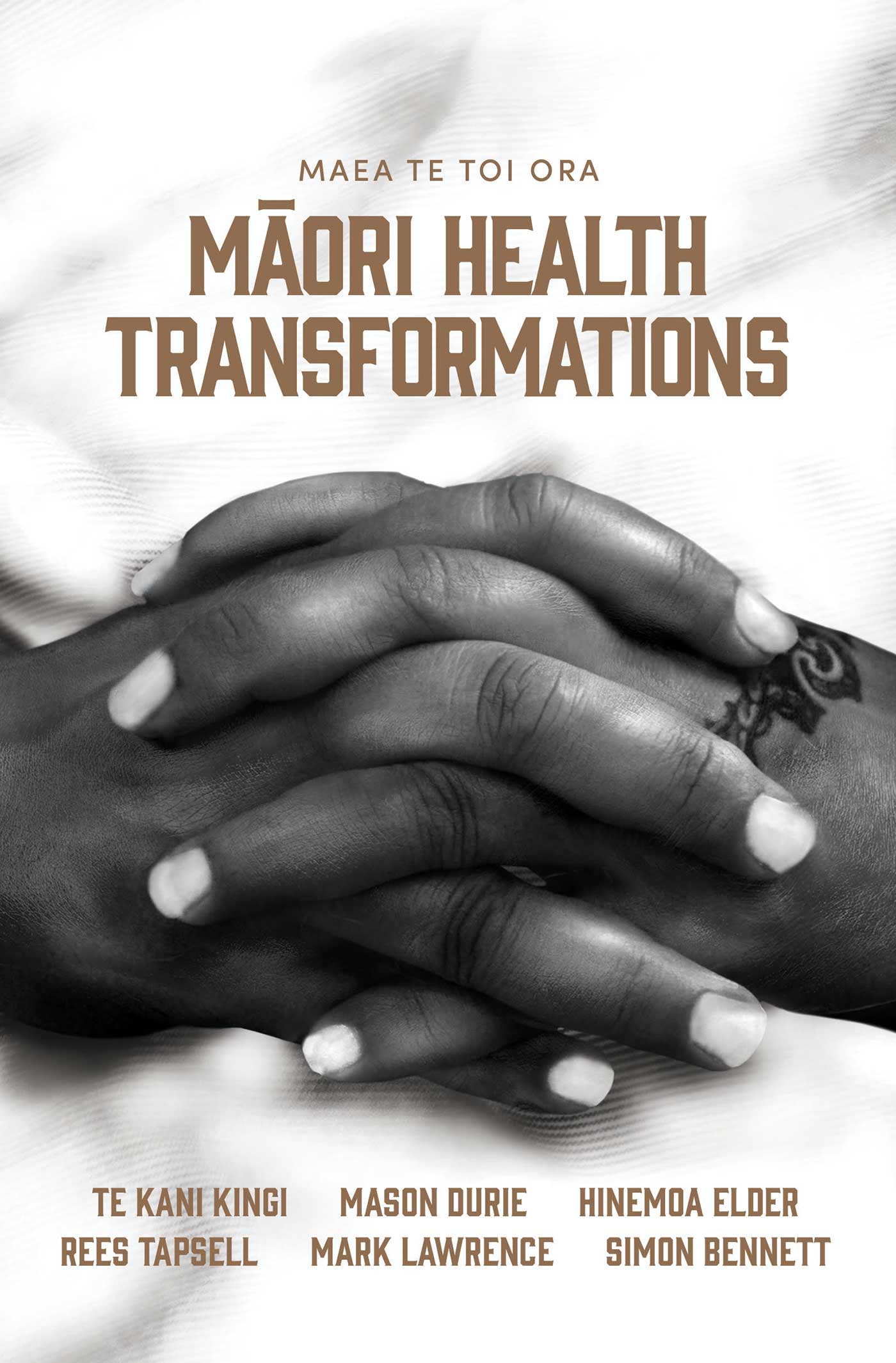


First published in 2017 by Huia Publishers
39 Pipitea Street, PO Box 12280
Wellington, Aotearoa New Zealand
www.huia.co.nz
ISBN 978-1-77550-297-5 (print)
ISBN 978-1-77550-346-0 (EPUB)
ISBN 978-1-77550-347-7 (Kindle)
Copyright the authors 2017
Photograph of Hinemoa Elder: Melanie Peters, Melt Photography
Ebook conversion 2017 by meBooks
This book is copyright. Apart from fair dealing for the purpose of private study, research, criticism or review, as permitted under the Copyright Act, no part may be reproduced by any process without the prior permission of the publisher.
A catalogue record for this book is available from the National Library of New Zealand.
Published with the assistance of Ng Pae o te Mramatanga

TE KANI KINGI
Research into Mori mental health has been neither extensive nor consistent, and for these reasons, building a comprehensive profile of patterns and trends has always been a challenge. Notwithstanding these difficulties, it is possible to gain an understanding of relevant concerns, highlight major issues and, at least, review the existing research and available evidence.
This introductory chapter carries out that purpose, providing a foundation for the book and a rationale for its focus on Mori mental health. Until recently, data on Mori mental health was at best vague, and it was difficult to determine the extent to which mental health problems affected Mori. While research and enhanced data collections have improved our understanding of contemporary issues and concerns, plotting the history and development of Mori mental health has been far more challenging.
The perspectives were too often derived from the impressions of non-Mori: those unfamiliar with Mori society, who were, ultimately, unable to divorce their own cultural bias from clinical assumptions.
The issue of diagnosis and interpretation of illness was a major concern. While afflictions of the body would manifest in tangible forms, diseases of the mind were less audible, less understood and more open to incomplete interpretation and prejudice. Putting aside the complexities of diagnosis, mental health problems can be defined according to a set of parameters that govern the extent to which behaviour is accepted or otherwise classified as abnormal. Often these parameters are founded on notions of normality, which, more often than not, are grounded in cultural bias. What is rational and clear in one system of knowledge may become distorted and misread if it is analysed within the constructs of another.
Illustrations such as this reveal the challenge of interpreting historical descriptions as evidence of mental health or illness. Nonetheless, the earliest impressions of Mori mental health were inevitably informed by the perspectives of non-Mori, however flawed and regardless of their accuracy and intent. A cautious and considered approach is therefore needed when examining what was written, what was said and what was implied.
Putting these issues aside, there are at least two broad conclusions that can be made about Mori mental health. The first is that mental illness (as defined according to Western criteria) is likely to have existed within Mori communities before European contact. This conclusion is simply based on the notion that mental disorders have been known to occur within all cultures and that it is most unlikely that Mori alone could have developed the means, biological or otherwise, by which such conditions (now termed mental disorders) could have been avoided. Leaving aside the difficulties in equating these words with psychosis or other serious disorders, the words themselves suggest a departure from the norms of the community and at least a recognition of abnormal states of mind.
Within traditional waiata, further examples of mental distress can be found. The Ngti Whakaue waiata tangi Te Atua Matakore Even when accounting for our imperfect understanding of the circumstances that led to this event, it is known that the act of suicide is most typically preceded by significant emotional turmoil (often stress or depression).
In considering how these types of manifestations of the mind might have been perceived by Mori, Sachdev Beaglehole held a similar opinion:
the phenomenon of mental disease brings a catch of anxiety and fright to the Maori (as it has to the Pakeha in the past and still does to many Pakeha today) which he tries to understand in
While both Beaglehole and Sachdev appear to support the idea that mental illness was unfamiliar to Mori, they do not rule out the presence of abnormal states and the use of cultural paradigms to explain them. However, in the end, they favour a Western view and appear to regard the Mori explanation as a proxy for more informed opinion. That is, cultural frames were often used by Mori to explain issues that (in their mind at least) were clearly evidence of mental illness.
The second assumption about Mori mental health leads on from the first and centres on the idea that the current comparatively high rates of Mori mental illness are a recent phenomenon. Again, the available data are scarce and should be interpreted cautiously, yet it is sufficiently consistent enough to suggest that mental health problems were not of major concern to Mori in traditional times.
A broad analysis of writings on Mori during the 1800s reveals the emergence of two main themes. The first is that early descriptions of Mori (at least in terms of their health and well-being) were largely positive. Life expectancy was on a par with other parts of the world, and while the population was not immune to illness and disease, the impression was that of a sophisticated society that was healthy, robust and resilient. The second is that by the end of the century an entirely different picture was presented and real concerns were being raised about the ongoing survival of the race whether or not Mori would be extinct within a generation or two. In 1814, John Liddiard Nicholas, a London iron founder, accompanied Samuel Marsden on a journey of exploration to New Zealand. The expedition was intended to establish a Christian mission, though it also provided an opportunity for Nicholas to observe Mori and to later publish a two-volume book on his observations. An extract is provided below:
I never thought it likely they could be so fine a race of people as I now found them. They generally rose above the middle stature, some were even six feet and upwards, and all their limbs were remarkable for perfect symmetry and great muscular strength. Their appearance was pleasing and intelligent.
Other observations were even more revealing and provided additional insight into the public health behaviours and nutritional habits of Mori:
So simple a diet accompanied with moderation must be productive of good health, which indeed these people are blessed within a very high degree I do not remember a single instance of a person distempered in any degree that came under my inspection
While it would be misleading to suggest that Mori were immune to illness and disease or that the stresses and strains of living were not significant, these observations provide useful descriptions of daily life, the values that shaped Mori behaviours and the comparative light in which Mori were viewed.
Font size:
Interval:
Bookmark:
Similar books «Maea te Toi Ora: Maori Health Transformations»
Look at similar books to Maea te Toi Ora: Maori Health Transformations. We have selected literature similar in name and meaning in the hope of providing readers with more options to find new, interesting, not yet read works.
Discussion, reviews of the book Maea te Toi Ora: Maori Health Transformations and just readers' own opinions. Leave your comments, write what you think about the work, its meaning or the main characters. Specify what exactly you liked and what you didn't like, and why you think so.

